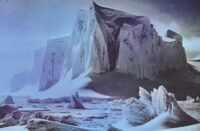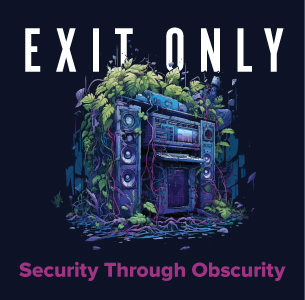
::..:::…..:..::….:::::..:::..:::::::……:::…::.:::….::::..:..:::…::…….::::
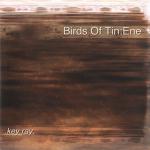 :: This is the first release on Belgium’s new limited edition CD-R label Mystery Sea. Bringing together Birds of Tin (Brooke Oates) and Ene (Scott Hudgins) this disc is at once an anesthetic for solace. On Open Doors the wash of squat loops phases through exotic and irregular tones. “Paper Lock” builds on a Christian radio broadcast of “sins and their inherent sacrifices.” After a minute or so of gibberish, the low-fi sonics throb through samples, like spinning a radio dial, built on jazz themes and other random oddities. In its nest of haunting rhythm is where I wish this baby bird would lay. Birds of Tin have released about a dozen or so recordings since 1996, most memorable on the few stints with Augur. Ene has played live with an incredible roster of diverse musicians from Kaffe Matthews and DJ Spooky to Matmos and The Haters. “Clear Passage Through” continues its foray into its Christian sample ramblings. Its edge is defined in its own bloated, illusionist phrasing and deconstruction. As it develops, an ambient synthesis of layered tones and encrusted noise filters make for pure experimental fare. I am suddenly in a lengthy corridor of an international airport after having been blindfolded for 48 hours. The chilling spatial concepts are endless on this disc. Samples, sequencers, filters and a no-holds-barred approach make this the type of nail biting listen one craves from a pulp urban reality. Entry has a pitch glow of nighttime metropolis in its farthest corners where only the graveyard shift toils like a Persian mole. The anchor of the recording can be dredged up through its Endless Empty, rich in its wind tunnel noise and vacuum-like antics. Closing with the title track, Oates and Hudgins combine altered forces in this submerged work of electronic fury. It’s a glitch-filled, open wired symphony that loops in its introspection. The ragged sine waves seem to attempt a transmission in synthetic tongues. Whatever the message, it is clear that the mission is accomplished in Key Ray.
:: This is the first release on Belgium’s new limited edition CD-R label Mystery Sea. Bringing together Birds of Tin (Brooke Oates) and Ene (Scott Hudgins) this disc is at once an anesthetic for solace. On Open Doors the wash of squat loops phases through exotic and irregular tones. “Paper Lock” builds on a Christian radio broadcast of “sins and their inherent sacrifices.” After a minute or so of gibberish, the low-fi sonics throb through samples, like spinning a radio dial, built on jazz themes and other random oddities. In its nest of haunting rhythm is where I wish this baby bird would lay. Birds of Tin have released about a dozen or so recordings since 1996, most memorable on the few stints with Augur. Ene has played live with an incredible roster of diverse musicians from Kaffe Matthews and DJ Spooky to Matmos and The Haters. “Clear Passage Through” continues its foray into its Christian sample ramblings. Its edge is defined in its own bloated, illusionist phrasing and deconstruction. As it develops, an ambient synthesis of layered tones and encrusted noise filters make for pure experimental fare. I am suddenly in a lengthy corridor of an international airport after having been blindfolded for 48 hours. The chilling spatial concepts are endless on this disc. Samples, sequencers, filters and a no-holds-barred approach make this the type of nail biting listen one craves from a pulp urban reality. Entry has a pitch glow of nighttime metropolis in its farthest corners where only the graveyard shift toils like a Persian mole. The anchor of the recording can be dredged up through its Endless Empty, rich in its wind tunnel noise and vacuum-like antics. Closing with the title track, Oates and Hudgins combine altered forces in this submerged work of electronic fury. It’s a glitch-filled, open wired symphony that loops in its introspection. The ragged sine waves seem to attempt a transmission in synthetic tongues. Whatever the message, it is clear that the mission is accomplished in Key Ray.
::..:::…..:..::….:::::..:::..:::::::……:::…::.:::….::::..:..:::…::…….::::
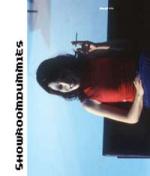 :: Peter Rehberg has brought together a cast of a dozen to realize this new project. This French choreographic creation was hosted by the Choreographic Center Nationalde Grenoble, under the artistic direction of Etienne Bideau-Rey and Gisele Vienna. Visually based on hideously realized ivory painted mutations with clown make-up, these women are lost creatures in heels. This is a picture of lost innocence in the era of other such deviations as Miss Kittin and Ladytron. The cold, icy rumblings Rehberg issues codify this lost species. This marionette-like fusion between subject and object makes for an appealing and quirky listen. Rehberg, probably better known as his alter sound persona Pita, has recorded a sharply mechanized electronosphere in this collaboration.
:: Peter Rehberg has brought together a cast of a dozen to realize this new project. This French choreographic creation was hosted by the Choreographic Center Nationalde Grenoble, under the artistic direction of Etienne Bideau-Rey and Gisele Vienna. Visually based on hideously realized ivory painted mutations with clown make-up, these women are lost creatures in heels. This is a picture of lost innocence in the era of other such deviations as Miss Kittin and Ladytron. The cold, icy rumblings Rehberg issues codify this lost species. This marionette-like fusion between subject and object makes for an appealing and quirky listen. Rehberg, probably better known as his alter sound persona Pita, has recorded a sharply mechanized electronosphere in this collaboration.
In these eleven unnamed tracks this English-born, Austrian resident has veered a bit towards the more colorful, gaming side of his genre. Having collaborated with Kaffe Matthews, Fennesz and Jim O’Rourke, he has had a suitable upbringing of late. There are knobs twiddling, vinyl in its lockgroove, and a variety of kitschy and sweet bleeps. Escaping the instant Kraftwerk title recognition would be impossible – but there is hardly any reference to their throne forseen herein. In one of her most startling confrontational designs Tina Frank makes the cover of this disc a work of post modern bliss. Rehberg does not spare us his proclivity for building atmosphere in this piece meant to accompany performance. A wide spectrum of space is built around deep drone-filled echoes with sharp jagged cuts. His template is a temperate blend of abstractions that verge on the edge of funk, but never quite go there on this effort. On one track we hear what might sound like the inside of a cello if it were contact mic’d in an isolation chamber. There are no immediate references on this extreme original soundtrack for a company that uses the body as a shell to depict the inanimate. Blaring feedback makes way for disconcerting mechanized repetition doing double duty towards the disc’s closure. The fiery final track seems as if it won’t let go. The funky harmony is a duet between sounds that simulate a chainsaw cutting vibes and a casiotone-styled funhouse organ. This is the type of recording that asserts that recess is over, for sure.
::..:::…..:..::….:::::..:::..:::::::……:::…::.:::….::::..:..:::…::…….::::
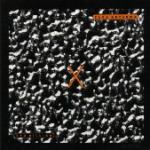 :: Hubble starts off like the shards from the Hendrix (as in Jimi) shuttle. Indeed a trip! This electroacoustic mesh of guitars and samples is an understated meeting of contemporary electronica and heavy metal, without its farce and circumstance. The lovely distortion on “Leaving Medford wriggles in Oregonian tongue and then shoots off into a distant galaxy to meet Steve Vai for a moment of reckoning. Now, don’t get me wrong, this is by no means late 80s schlock rock, though it does playfully walk its lines by way of the language of strings. This is a much less accessible alternative, especially as heard on Last Sparrow, with its warped loop filtering and Asian theme. This distortion has more in common with KK Null than Tommy Lee and bares this disc’s finest moment in repose. Parts Tortoise, parts Eiko & Koma, “Last Sparrow” is equivalent to a carwash with mercury having replaced the water and suds. “Nocturnal Interstices” is a Pacific Northwest coastal drive on a typical inclement evening. Its wash of passing vehicles, waves and stormy weather are trance inducing. Killian uses his MIDI instrument like an ancient lyre charming the fear from night. There is a funky humorist about in the concave Reverse Logic as it winds and shimmys with guitarese. Call it fusion, but above its pap and underestimation of its audience, this guy sounds like he is having fun. Over and above this record will not be for those who caution guitar squealers, but it is in its more abstract and introspective moments that this disc succeeds and revels. And those moments are aplenty on Flux Aeterna.
:: Hubble starts off like the shards from the Hendrix (as in Jimi) shuttle. Indeed a trip! This electroacoustic mesh of guitars and samples is an understated meeting of contemporary electronica and heavy metal, without its farce and circumstance. The lovely distortion on “Leaving Medford wriggles in Oregonian tongue and then shoots off into a distant galaxy to meet Steve Vai for a moment of reckoning. Now, don’t get me wrong, this is by no means late 80s schlock rock, though it does playfully walk its lines by way of the language of strings. This is a much less accessible alternative, especially as heard on Last Sparrow, with its warped loop filtering and Asian theme. This distortion has more in common with KK Null than Tommy Lee and bares this disc’s finest moment in repose. Parts Tortoise, parts Eiko & Koma, “Last Sparrow” is equivalent to a carwash with mercury having replaced the water and suds. “Nocturnal Interstices” is a Pacific Northwest coastal drive on a typical inclement evening. Its wash of passing vehicles, waves and stormy weather are trance inducing. Killian uses his MIDI instrument like an ancient lyre charming the fear from night. There is a funky humorist about in the concave Reverse Logic as it winds and shimmys with guitarese. Call it fusion, but above its pap and underestimation of its audience, this guy sounds like he is having fun. Over and above this record will not be for those who caution guitar squealers, but it is in its more abstract and introspective moments that this disc succeeds and revels. And those moments are aplenty on Flux Aeterna.
::..:::…..:..::….:::::..:::..:::::::……:::…::.:::….::::..:..:::…::…….::::
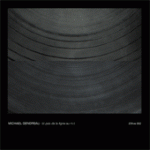 :: 23five Incorporated is a San Francisco non-profit organization founded in 1993 and dedicated to the education and discussion of sound as a medium in the public arena. This is the first of two releases by the label this year and certainly heightens one’s awareness of the possibilities in the ongoing dialogue of sound and its infinite sources. On his debut solo effort, Bay Area experimenter Michael Gendreau (Crawling With Tarts), is in fine form (or reduction of it so to speak). The two track set includes “Two Worlds for Now,” a disconnected horizon line whose plug gets pulled at its conclusion. While exploring the unexpected potential of turntable motors and mechanisms Gendreau has ruptured some preconceptions of tools underneath which would ordinarily be used to listen to any old vinyl. This deconstructionist approach to undersized sound makes for a recording that is almost, in essence, what is “left” of sound, the resonance. This is an atypical ambient release, with a low-end sizzle and hum in a vacuous space with minor mechanical goings-on. In its puzzling bellows, the 35-minute title track leads the listener astray as it rambles in its physics and amplified world of micro-sound. Here there are hints of data transfer and voice channeling that has at once a startling approach and tectonic finish. The repetitive churning of teeny motorized units, in their climbing, distorted frequencies will have you hanging on each transition. Some of the finer sources play with the idea of scale, while at times these palm-sized worlds grow into 300 foot tall super coasters, and in moments they are again transformed smaller than a pinhead. 23five is ready to challenge our ears with visionary work that pushes the barriers of the noise/sound envelope.
:: 23five Incorporated is a San Francisco non-profit organization founded in 1993 and dedicated to the education and discussion of sound as a medium in the public arena. This is the first of two releases by the label this year and certainly heightens one’s awareness of the possibilities in the ongoing dialogue of sound and its infinite sources. On his debut solo effort, Bay Area experimenter Michael Gendreau (Crawling With Tarts), is in fine form (or reduction of it so to speak). The two track set includes “Two Worlds for Now,” a disconnected horizon line whose plug gets pulled at its conclusion. While exploring the unexpected potential of turntable motors and mechanisms Gendreau has ruptured some preconceptions of tools underneath which would ordinarily be used to listen to any old vinyl. This deconstructionist approach to undersized sound makes for a recording that is almost, in essence, what is “left” of sound, the resonance. This is an atypical ambient release, with a low-end sizzle and hum in a vacuous space with minor mechanical goings-on. In its puzzling bellows, the 35-minute title track leads the listener astray as it rambles in its physics and amplified world of micro-sound. Here there are hints of data transfer and voice channeling that has at once a startling approach and tectonic finish. The repetitive churning of teeny motorized units, in their climbing, distorted frequencies will have you hanging on each transition. Some of the finer sources play with the idea of scale, while at times these palm-sized worlds grow into 300 foot tall super coasters, and in moments they are again transformed smaller than a pinhead. 23five is ready to challenge our ears with visionary work that pushes the barriers of the noise/sound envelope.
::..:::…..:..::….:::::..:::..:::::::……:::…::.:::….::::..:..:::…::…….::::
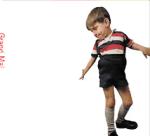 :: “Er Sagt Zu Ihr Sie Sagt Zu Ihm” (He talks to her she talks to him) starts this disc off with a woman speaking Evelyn Wood-speed German gibberish. Grand Mal (Justin Bennett, Stephie Büttrich and Anne Wellmer) play with words, percussion and electronics to effect. Along the way we hear bells blurring, muffled speakers, stop-start actions and a whole lot of weird stuff that just makes you think. Unsounds seems to be a new player in the world of what is possible in sound dialogue. Other releases by Kaffe Matthews/ Andy Moor and Yannis Kyriakides attest of their niche in this untouched market of impromptu, detached musical theater. The only thing is there is no theater in sight – these works have more in common with radio plays than they do with any accessible contemporary music. Actually, portions were recorded live at the Korzo Theater in Den Haag. On “Perfect Fit” Büttrich bears the fruits of a cabaret singer with a penchant for the blurtacious wailing instantly crossing the worlds of Karen Finley and Eartha Kitt.
:: “Er Sagt Zu Ihr Sie Sagt Zu Ihm” (He talks to her she talks to him) starts this disc off with a woman speaking Evelyn Wood-speed German gibberish. Grand Mal (Justin Bennett, Stephie Büttrich and Anne Wellmer) play with words, percussion and electronics to effect. Along the way we hear bells blurring, muffled speakers, stop-start actions and a whole lot of weird stuff that just makes you think. Unsounds seems to be a new player in the world of what is possible in sound dialogue. Other releases by Kaffe Matthews/ Andy Moor and Yannis Kyriakides attest of their niche in this untouched market of impromptu, detached musical theater. The only thing is there is no theater in sight – these works have more in common with radio plays than they do with any accessible contemporary music. Actually, portions were recorded live at the Korzo Theater in Den Haag. On “Perfect Fit” Büttrich bears the fruits of a cabaret singer with a penchant for the blurtacious wailing instantly crossing the worlds of Karen Finley and Eartha Kitt.
In all its feline growl and scotch drenched tongue curling (minus the water back), the sick manipulations on tracks like “Peel Me A Grape” appeal to the most discerning listener (if your listener didn’t have a single Julie London record hidden away somewhere). This recording is laden with awkward atrophied voice and Bennett’s deep jungle percussive pitter-patter. On “The Sirens,” crazed women tribes haunch and lure us in like their daily prey. “©” is a convoluted sliced up ping-pong like conversation with a snare beat and byte. The harsh hacking “Schat” illustrates its title (I hope it wasn’t funded by the NEA!). In the Charlie Mingus penned Eclipse the trio pays an evocative lazy homage to its master. Büttrich’s mostly un-altered voice here is not spared by its dimensional noise assemblage at its breathy edge. “707” reprises Laurie Anderson’s classic “From The Air” and manipulates it with sinister detail, given events of late. It’s crazed flight attendant becomes a hyper-colorful Ren & Stimpy send off with fangs in place of wings. Wellmer cuts and pastes Bennett’s zither reducing any of its zen possibilities from the outset on Far East. I am overcome with grande visions of the pageantry of the King & I cutting to blips of Re-Run hollering “Hey You Guys!” “Lullaby” is a seven minute howl and whisper. Rather than your typical ending, this is an active listener’s record until the cows come home. This is a siren song with hints of churning piglets and other farm animals off the record. What results here is an original disc that would make Kurt Schwitters proud.
::..:::…..:..::….:::::..:::..:::::::……:::…::.:::….::::..:..:::…::…….::::
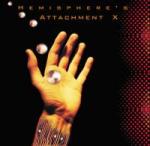 :: Attachment X is a remixed compendium of ambient recordings by the German duo Hemisphere (Ralf Knappe-Heinbockel and Thorsten Reinhardt) made over the last decade between 1991-2001. Nearly 80 minutes, Attachment X is an amorphous long-play collage of harmonics and sequencers. Its tracks, called “Points” graciously honor past achievements of Tangerine Dream and Jean Michel Jarre, while carving out their own programming niche. Reinhardt’s guitar floats and drifts to Knappe-Heinbockel’s streamlined keyboard phrasing which percolates in and out of the foreground. This disc plays like an electronic operetta, perhaps best experienced at the conclusion of something like the Burning Man festival, or as a soundtrack to an opium den. Lost in the darkest shadows are glints of residual heat from a recent storm, gestures of lurking presences, risky passages to lunar caverns. This is a total trance-inducing complement to, perhaps, documentary footage of an alien’s first step on earth, or the impending gesture of crop circles in the making. There is an inherent sadness or sense of detached loss as the disc comes to conclusion in its final tracks. It is like a wave to a foreign world left behind, a bittersweet finale.
:: Attachment X is a remixed compendium of ambient recordings by the German duo Hemisphere (Ralf Knappe-Heinbockel and Thorsten Reinhardt) made over the last decade between 1991-2001. Nearly 80 minutes, Attachment X is an amorphous long-play collage of harmonics and sequencers. Its tracks, called “Points” graciously honor past achievements of Tangerine Dream and Jean Michel Jarre, while carving out their own programming niche. Reinhardt’s guitar floats and drifts to Knappe-Heinbockel’s streamlined keyboard phrasing which percolates in and out of the foreground. This disc plays like an electronic operetta, perhaps best experienced at the conclusion of something like the Burning Man festival, or as a soundtrack to an opium den. Lost in the darkest shadows are glints of residual heat from a recent storm, gestures of lurking presences, risky passages to lunar caverns. This is a total trance-inducing complement to, perhaps, documentary footage of an alien’s first step on earth, or the impending gesture of crop circles in the making. There is an inherent sadness or sense of detached loss as the disc comes to conclusion in its final tracks. It is like a wave to a foreign world left behind, a bittersweet finale.
::..:::…..:..::….:::::..:::..:::::::……:::…::.:::….::::..:..:::…::…….::::
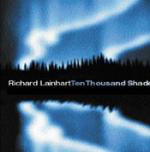 :: Talk about retrospectives –here we have Ten Thousand Shades of Blue, a master 2xCD collection of composed works dating between 1975-89. Opening with “Bronze Cloud Disk (1975),” audio-video artist Richard Lainhart (Periodic Music, Vacant Lot) shows early signs of possible undiscovered worlds in the era of early Eno. This 1/2 hour long track is a cerebral journey pieced together with multi-processing to create a din of tone structures that warps the room. The center of this work is a sonically invigorated, bowed tam-tam (a metal gong). I keep thinking that Lainhart and Tom Heasley should play in the same room together when being submerged inside this chamber of cinematic drone. “Two Mirrors Face One Another (1976),” uses similar techniques of filtering tracks of Japanese temple bells. Quite a jump out of the water for a man who formerly played vibes in a swing band. This startling 40-minute long (excerpted from an hour) track has Lainhart using a bowing technique on the bells which is like a secret coding. The pitch gets right inside your head and swirls in slow-motion.
:: Talk about retrospectives –here we have Ten Thousand Shades of Blue, a master 2xCD collection of composed works dating between 1975-89. Opening with “Bronze Cloud Disk (1975),” audio-video artist Richard Lainhart (Periodic Music, Vacant Lot) shows early signs of possible undiscovered worlds in the era of early Eno. This 1/2 hour long track is a cerebral journey pieced together with multi-processing to create a din of tone structures that warps the room. The center of this work is a sonically invigorated, bowed tam-tam (a metal gong). I keep thinking that Lainhart and Tom Heasley should play in the same room together when being submerged inside this chamber of cinematic drone. “Two Mirrors Face One Another (1976),” uses similar techniques of filtering tracks of Japanese temple bells. Quite a jump out of the water for a man who formerly played vibes in a swing band. This startling 40-minute long (excerpted from an hour) track has Lainhart using a bowing technique on the bells which is like a secret coding. The pitch gets right inside your head and swirls in slow-motion.
On disc two, “Cities of Light (1980)” fills the air with the rich and deep bellowing, multi-phonic vocal technique which is traditionally used by Tibetan Monks. The tones and pitch shifting hover way down low, settling the mind-body-spirit continuum. The title track uses a bevy of Macs to create a real-time performance. Lainhart used SoftSynth (by Digidesign) to synthesize the many layers of this completely digital track. As a technical director, Lainhart has written several manuals for music and video hardware and software. With no digital accompaniment on the vibraphonic “Walking Slowly Backwards (1989)” we are treated to an imaginative and centering work. Its subtleties are in hues, like many brilliant shades of blue, you might say. I say this is an enlightened, provocative set worthy of multiple listens. This could be real mood music, just add light and air and stir!
::..:::…..:..::….:::::..:::..:::::::……:::…::.:::….::::..:..:::…::…….::::
 :: Never judge a book by its cover – a true lesson when it came to giving serious consideration to reviewing this disc. The cover design is just plain busy and unnecessarily gothic, giving away too much before you get to experience the real treasures held inside! OK, that aside, I am pleased to have given this one a comprehensive spin. Nashville’s own Brannan Lane couldn’t be further from the Grand Ole Opry on the mesmerizing “Cavern 1 – Black Air.” Multiple dark ambient layers are richly drenched in a continuous flow of multi-tracked fountains. “Thera” (a volcanic island also known as Santorini), as stated on the CD jacket, is the Greek word for fear, and realizing its somber embrace is Lane’s task on this hour long player. We hear angelic swirls, deep tonal gongs reverberating and building with percussive resonance. Having been heard on the radio broadcast show Music from the Hearts of Space, this sound sculptor seems rightly fitted for the task of creating atmosphere. If this were a film soundtrack we see 20 story high cavernous and icy hollows and are surrounded by mystical enchanted haunted kingdoms. This disc renders the listener passive and encircled by its space. “Cavern II – Ancient Art” continues to build on the growing cinematic harmonies building an arsenal of sound. Spirits rise up high and converge in a twisting iridescence on the short and effective “Death from Above.” Bodies of water drip, spill and flood throughout this adventure, at times quite stimulating, at other times menacing. “Sea In The Dark” is like a winding vessel reminiscent of surveying an imaginary alter-world, Atlantis perhaps? The illusions run deep here. Lane’s ability to capture stimulant and visionary atmosphere comes from his work in multiple genres, from Caribbean to Country, from Trance to Blues. Some may say this provocative composer may be reaching too far. I can only hope he opts for creating more work in this mode. There are a lot of repetitive sound themes over the generous hour here, but Lane brings us into a trance-like state and then “Into the Light.” On this final track it is as though we have channeled to the other side of a virtual landscape. We have been released from the mysterious magnetic pull and sail away with a galaxy of wildlife. This, my first exposure, to an artist with a dozen or so recordings in his name, was certainly worth the trip!
:: Never judge a book by its cover – a true lesson when it came to giving serious consideration to reviewing this disc. The cover design is just plain busy and unnecessarily gothic, giving away too much before you get to experience the real treasures held inside! OK, that aside, I am pleased to have given this one a comprehensive spin. Nashville’s own Brannan Lane couldn’t be further from the Grand Ole Opry on the mesmerizing “Cavern 1 – Black Air.” Multiple dark ambient layers are richly drenched in a continuous flow of multi-tracked fountains. “Thera” (a volcanic island also known as Santorini), as stated on the CD jacket, is the Greek word for fear, and realizing its somber embrace is Lane’s task on this hour long player. We hear angelic swirls, deep tonal gongs reverberating and building with percussive resonance. Having been heard on the radio broadcast show Music from the Hearts of Space, this sound sculptor seems rightly fitted for the task of creating atmosphere. If this were a film soundtrack we see 20 story high cavernous and icy hollows and are surrounded by mystical enchanted haunted kingdoms. This disc renders the listener passive and encircled by its space. “Cavern II – Ancient Art” continues to build on the growing cinematic harmonies building an arsenal of sound. Spirits rise up high and converge in a twisting iridescence on the short and effective “Death from Above.” Bodies of water drip, spill and flood throughout this adventure, at times quite stimulating, at other times menacing. “Sea In The Dark” is like a winding vessel reminiscent of surveying an imaginary alter-world, Atlantis perhaps? The illusions run deep here. Lane’s ability to capture stimulant and visionary atmosphere comes from his work in multiple genres, from Caribbean to Country, from Trance to Blues. Some may say this provocative composer may be reaching too far. I can only hope he opts for creating more work in this mode. There are a lot of repetitive sound themes over the generous hour here, but Lane brings us into a trance-like state and then “Into the Light.” On this final track it is as though we have channeled to the other side of a virtual landscape. We have been released from the mysterious magnetic pull and sail away with a galaxy of wildlife. This, my first exposure, to an artist with a dozen or so recordings in his name, was certainly worth the trip!
::..:::…..:..::….:::::..:::..:::::::……:::…::.:::….::::..:..:::…::…….::::
 :: Alan Bloor (Knurl) releases In Accordance With Conscience using metals of various tensile strength as the primary sound source. This is the type of recording I hope for in a stack, like a wasteland, of needless notes and empty airspace. “Form and Hold” is a haunting starter track, reviving the ghosts of experimental elders. Its metal play has a crypt-like gothic quality, all slow-motion, all darkly lush. Having collaborated with Aube, Canadian noise artist Bloor is no stranger to his ambient medium, having tinkered with scrap metals and other found objects in his past. On “To Regard As Being” we are treated to an atmosphere so sparse, yet so expansive. The sound is infinite in its primary tonalities. With no overdubbing this disc is noise purity at its most minimal extreme. Deviating further in “Solecism,” Pholde provides us with the colloquial solution to our darkest hours, a nightmarish mirage where the only reflection is of oneself, ad infinitum. Ancient castles, ruins and torture chambers illuminate with visual license here. There is a very sub-deep impression of remote movement in “Any of Various Compounds.” A prototypical altered world, so minute it could live within another being. The audience is treated to live bowing of intangible objects which are in essence heavy and about dimension and weight. Bloor’s treatment sterilizes our expectation of what can be heard inside this android world of metallics. “Centered Over A Point” closes this 40-minute recording with breathtaking mystery. In a class with only Maeror Tri and possibly :zoviet*france:, Pholde is one of the few current artists presenting work of such serious daring experimentation.
:: Alan Bloor (Knurl) releases In Accordance With Conscience using metals of various tensile strength as the primary sound source. This is the type of recording I hope for in a stack, like a wasteland, of needless notes and empty airspace. “Form and Hold” is a haunting starter track, reviving the ghosts of experimental elders. Its metal play has a crypt-like gothic quality, all slow-motion, all darkly lush. Having collaborated with Aube, Canadian noise artist Bloor is no stranger to his ambient medium, having tinkered with scrap metals and other found objects in his past. On “To Regard As Being” we are treated to an atmosphere so sparse, yet so expansive. The sound is infinite in its primary tonalities. With no overdubbing this disc is noise purity at its most minimal extreme. Deviating further in “Solecism,” Pholde provides us with the colloquial solution to our darkest hours, a nightmarish mirage where the only reflection is of oneself, ad infinitum. Ancient castles, ruins and torture chambers illuminate with visual license here. There is a very sub-deep impression of remote movement in “Any of Various Compounds.” A prototypical altered world, so minute it could live within another being. The audience is treated to live bowing of intangible objects which are in essence heavy and about dimension and weight. Bloor’s treatment sterilizes our expectation of what can be heard inside this android world of metallics. “Centered Over A Point” closes this 40-minute recording with breathtaking mystery. In a class with only Maeror Tri and possibly :zoviet*france:, Pholde is one of the few current artists presenting work of such serious daring experimentation.
::..:::…..:..::….:::::..:::..:::::::……:::…::.:::….::::..:..:::…::…….::::
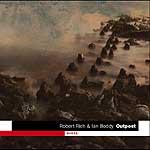 :: Outpost is the coming together of San Francisco’s prolific ambient maestro Robert Rich and Britain’s illusionistic, synthesist Ian Boddy, both recording since the early 80s. “Ice Fields” has an expansive sound with twinkling interludes of poppy tonalities which lead into the darker atonal Methane softening the space and changing the multi-colors to grayscale. Its introspection is its key to the sequenced boundaries building slowly in “Lagrange Point.” In this track we calmly travel at about 40 mph through barren land with only minute traces of life. With the ample use of both vintage and modern electronics these two men have concocted a sterling debut that took them to each others countries to record. Dark atmospheres imbue tiny objects in its way, this is space-time travel. In “Link Lost,” which is the centerpiece of the disc, there is a quiet, distant music box evoking dreams of lost childhood and an impending, subtle, almost disconnected, tribal warning call. Most of the recording is altered state inducing, classic ambient. “Edge of Nowhere” drives a slow shifting bpm with soaring high tone drone and layers of mysterious siren calls. “Last Outpost” aptly ties the whole journey together with its sensitive capture of leftover percussive abstractions and quietude, putting the listener to rest and letting them leave on their own voyage. Known for his all-night Sleep Concerts, Rich has developed a psychically charged sound that prepares the body for rest, contemplation and various meditative states. Having collaborated with like electronic artists such as Lustmord, Alio Die and Steve Roach, his collaboration with Ian Boddy seems like a natural choice – and a victorious end result. DiN is Boddy’s imprint, strictly set up to release limited edition contemporary electronica. Including recordings with Chris Carter, Arc and Markus Reuter, this is DiN’s 11th release since 1999 and if this is any sign of what’s in-store, check out the site so you “Catch it before you miss it.”
:: Outpost is the coming together of San Francisco’s prolific ambient maestro Robert Rich and Britain’s illusionistic, synthesist Ian Boddy, both recording since the early 80s. “Ice Fields” has an expansive sound with twinkling interludes of poppy tonalities which lead into the darker atonal Methane softening the space and changing the multi-colors to grayscale. Its introspection is its key to the sequenced boundaries building slowly in “Lagrange Point.” In this track we calmly travel at about 40 mph through barren land with only minute traces of life. With the ample use of both vintage and modern electronics these two men have concocted a sterling debut that took them to each others countries to record. Dark atmospheres imbue tiny objects in its way, this is space-time travel. In “Link Lost,” which is the centerpiece of the disc, there is a quiet, distant music box evoking dreams of lost childhood and an impending, subtle, almost disconnected, tribal warning call. Most of the recording is altered state inducing, classic ambient. “Edge of Nowhere” drives a slow shifting bpm with soaring high tone drone and layers of mysterious siren calls. “Last Outpost” aptly ties the whole journey together with its sensitive capture of leftover percussive abstractions and quietude, putting the listener to rest and letting them leave on their own voyage. Known for his all-night Sleep Concerts, Rich has developed a psychically charged sound that prepares the body for rest, contemplation and various meditative states. Having collaborated with like electronic artists such as Lustmord, Alio Die and Steve Roach, his collaboration with Ian Boddy seems like a natural choice – and a victorious end result. DiN is Boddy’s imprint, strictly set up to release limited edition contemporary electronica. Including recordings with Chris Carter, Arc and Markus Reuter, this is DiN’s 11th release since 1999 and if this is any sign of what’s in-store, check out the site so you “Catch it before you miss it.”
::..:::…..:..::….:::::..:::..:::::::……:::…::.:::….::::..:..:::…::…….::::
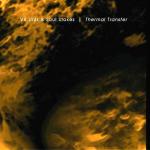 :: “Stroboscopic” is a helicopter sinking through a time warp in the Bermuda Triangle. This disc begs to be played at riskier volume. Tracks blend inside each other like a tidal wave of tropical vibration as in “Replicants in Orbit.” Vir Unis, last heard on the collaboration Blood Machine (Green House Music) with Steve Roach is in superb, groovy form on Thermal Transfer blending his sythesizers with the ample rhythms of the Bay Area’s Saul Stokes. Portland label Hypnos has established Binary, a sub-label forged in deeper groove-laden recordings with an emphasis on sequencer relationships. Modea’s “Liquid Metal” is a churning concoction of quirky percussion and smooth hand forged electronics via Stokes. This track merges fluidly into “Blurring Maguro” (which is then remixed for the disc’s final track). The “Interstitial” (John Koch-Northrup) remix crosses semblances between itself and Aphex Twin with an air of free-fusion electronics. This is a sizzling collaboration by two artists who normally reduce the bpms in half. Here we have a solid combine of two electronic wizards, making for an overall more buoyant, singular voice. Turning the tonal levels to a crispy, but darker element, “The Burning Ground” shrouds the listener in a heavy handed transitional track that emphasizes its weight. On the title track, the preeminent tick-tocking breathes an inverse, anxious sigh. An active listen that performs like stormy weather, complete with its own abstract fractal sunset. This is a recording that pulses above the line and beyond the pale.
:: “Stroboscopic” is a helicopter sinking through a time warp in the Bermuda Triangle. This disc begs to be played at riskier volume. Tracks blend inside each other like a tidal wave of tropical vibration as in “Replicants in Orbit.” Vir Unis, last heard on the collaboration Blood Machine (Green House Music) with Steve Roach is in superb, groovy form on Thermal Transfer blending his sythesizers with the ample rhythms of the Bay Area’s Saul Stokes. Portland label Hypnos has established Binary, a sub-label forged in deeper groove-laden recordings with an emphasis on sequencer relationships. Modea’s “Liquid Metal” is a churning concoction of quirky percussion and smooth hand forged electronics via Stokes. This track merges fluidly into “Blurring Maguro” (which is then remixed for the disc’s final track). The “Interstitial” (John Koch-Northrup) remix crosses semblances between itself and Aphex Twin with an air of free-fusion electronics. This is a sizzling collaboration by two artists who normally reduce the bpms in half. Here we have a solid combine of two electronic wizards, making for an overall more buoyant, singular voice. Turning the tonal levels to a crispy, but darker element, “The Burning Ground” shrouds the listener in a heavy handed transitional track that emphasizes its weight. On the title track, the preeminent tick-tocking breathes an inverse, anxious sigh. An active listen that performs like stormy weather, complete with its own abstract fractal sunset. This is a recording that pulses above the line and beyond the pale.
::..:::…..:..::….:::::..:::..:::::::……:::…::.:::….::::..:..:::…::…….::::
Essential Links ::
::..:::…..:..::….:::::..:::..:::::::……:::…::.:::….::::..:..:::…::…….::::
Note :: All reviews previously appeared in Instrumental Weekly.






